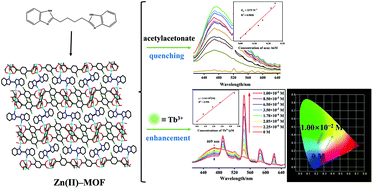A robust 3D zinc(ii)–organic framework for efficient dual detection of acetylacetone and Tb3+ ions†
Abstract
There has been broad attention to the recognition and detection of ions and organic small molecules due to their essential roles in environmental systems. However, dual-functional probes have seldom been developed for sensing organic constituents and lanthanide ions. A new 3D pillared Zn(II)−organic framework [Zn3(L)(DCTP)3]n (1) (L = 1,4-di(1H-benzo[d]imidazol-2-yl)butane and H2DCTP = 2,5-dichloroterephthalic acid) was hydrothermally synthesized and structurally characterized, and features a unique 3D 4,4,4,6-connected framework containing approximately 9.99 × 9.78 Å2 cubic channels. 1 displays excellent thermal and pH stability and can act as a novel “turn-on” fluorescent probe for highly selectively sensitizing Tb3+ ions through an “antenna effect”. Furthermore, 1 is a dual-response fluorescent sensor for monitoring acetylacetone and Tb3+ ions with rapid response times (within 1 min), low limits of detection (LOD) (5.02 × 10−6/1.15 × 10−8 M, separately) and great anti-interference ability and recyclability towards the analytes. The related sensing mechanisms for detecting analytes are also investigated in detail.

- This article is part of the themed collection: Dalton Transactions up-and-coming articles


 Please wait while we load your content...
Please wait while we load your content...